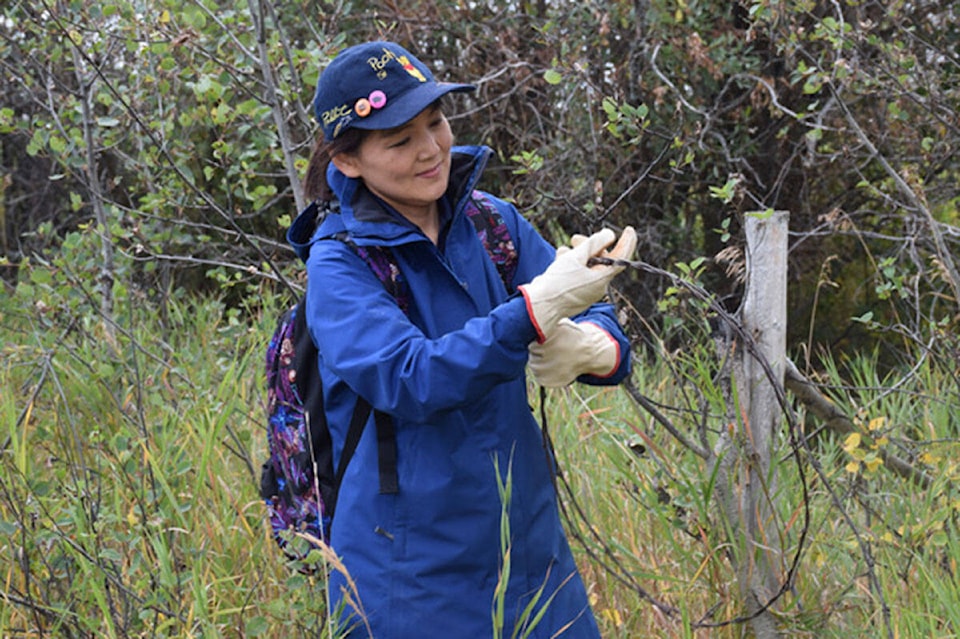Calling all wannabe barbed wire wranglers.
Nature Conservancy of Canada (NCC) is looking for a few helping hands to remove barbed wire fences from a pair of central Alberta properties overseen by the organization, which has conserved and restored more than 37 million acres of land across Canada since 1962.
“We are a land trust, so we acquire land to conserve forever. Once we’ve acquired the land, we need to steward and manage the land and maximize the benefits to eco-systems and wild species,” said Hannah Schaepsmeyer, NCC Alberta’s acting natural area manager for the Red Deer River Natural Area.
“So, that’s where our volunteers come in. There’s a range of activities we do in the Red Deer area. We do a lot of removing barbed wire fences, as well as pulling weeds and invasive species from our properties.”
The conservancy has nearly 12,500 acres of land in the Red Deer River Natural Area, which provides a habitat for a wide range of migratory birds and has the highest density of intact parkland in central Alberta.
Next month, the NCC hopes to make a couple of properties safer by removing old and rusting barbed wire fences. Schaepsmeyer said about 15 to 20 volunteers would be ideal for each of the projects.
The first takes place on May 14 from 10 a.m. to 3 p.m.at the Rachel Agnes Hayes Conservation Lands, which is near White Sands on Buffalo Lake. The area includes 1,146 acres of forest, grasslands and wetlands and is an important yellow ril and great blue heron habitat.
Another fence-pulling event is set for 10 a.m. to 3 p.m. at the Ferrier property, which is near Gough Lake, north of the Big Valley Campground. The 1,467-acre property was left to the NCC in the will of Nancy Ferrier, who passed away in 2015 and whose family had farmed the land since 1904.
No fence-pulling experience is necessary. “It’s competely beginner-friendly if you have never done it,” Schaepsmeyer said, adding conservancy staff will be on hand to offer help if needed.
“We provide all of the safety equipment required. We supply safety glasses, gloves and all the tools required. We start with a safety talk and a demonstration.
“It sounds like an intimidating process, but it’s really easy once you get the hang of it. Anyone is welcome to join, whether you have worked with barbed wire or not.
“Most people are rolling barbed wire like they have been doing it all of their life by the end of the day.”
Removing barbed wire fences is done to reduce the chance of injury for wildlife passing through the conservancy properties.
“Fences are important on the landscape. There are definitely areas where it is important to have fences. But a lot of time when we secure these properties there is infrastructure on it that we don’t need for our purposes.”
For those thinking of donating their time, there are a few things to be aware of. Volunteers must be at least 18 and should dress appropriately for the weather, which, as most know, can change quickly in central Alberta.
Long pants, waterproof boots and a rain jacket are recommended. Volunteers should bring their own lunch. Since volunteers will be wrestling with rusty old wire, an up-to-date tetanus shot is also recommended.
Those who want to lend a hand can register online or go to natureconservancy.ca and look for Alberta and then Events under Where We Work. You can also volunteer by email at: ab.volunteers@natureconservancy.ca. Detailed directions will be provided closer to the event.
The best way to keep on top of volunteer opportunities in your area is to sign up for the volunteer newsletter on the conservancy’s website.
The NCC’s partners in this area include Alberta Fish and Game Association, Alberta Conservation Association and Ducks Unlimited Canada.
